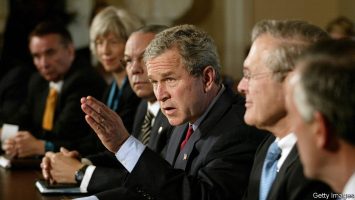
FROM TIME to time a chart circulates showing that virtually every job new in America over the past 35 years was created under a Democratic president (see chart 1). Often, the chart goes viral, and Democrats are only too happy to boast of their job-creating prowess. Since 1989 a mere 1.3m jobs have been created in net terms with Republicans in the Oval Office—despite the party’s reputation for being more business-friendly. With Democrats in power a net 49.4m jobs have been added. Defined narrowly—just considering monthly employment figures—the chart is indeed accurate. But a closer look at the data paints a different picture, showing a less marked contrast.

image: The Economist
Start with a simple point. It would be astonishing if the parties’ shifting fortunes truly led to such wildly different outcomes, almost overnight, for the American economy. Many things feed into growth trends that have only a scant connection to whoever is living in the White House—from the business cycle to tech innovations and Federal Reserve decisions to the global economy. At a minimum several adjustments to the jobs data are needed to make a fairer comparison.

Our first adjustment is to the period of time. Beginning with the presidency of George H.W. Bush in 1989 skews the outcome, since it omits America’s job performance under Ronald Reagan, who presided over a boom in the 1980s. It is fairer to date America’s modern economic trends to the late 1970s, and Jimmy Carter’s one-term presidency (see chart 2). This also covers a period during which Republican and Democratic parties were in the White House for roughly equal amounts of time, 24 years each. During this time Republican presidents have been in power for the creation of 17m jobs, whereas Democrats have been there for 60m. That is still a big gap (about 3.5 times as many jobs were created under Democrats as under Republicans) but not as large as the chasm that appears if the analysis starts in 1989 (a ratio of 39 to one).
Another objection to the first chart is that dumb luck accounts for much of the difference (see chart 3). George W. Bush caused neither the dot-com bust of the early 2000s nor the global financial crisis of 2007-09, but they book-ended his presidency. Both destroyed millions of jobs. The elder Bush, for his part, complained—with some justification—that an over-hawkish Fed undermined the economy while he was in the White House. And Donald Trump is not to blame for massive job losses at the height of the covid-19 pandemic. Moreover, after several of the downturns that weighed on Republican job figures, big rebounds flattered Democratic totals.

A better way to examine differences is to look at the median month for job creation in each presidency, thereby eliminating any unusually weak or strong periods. Analysed this way, Reagan and Mr Trump narrowly beat Barack Obama, though both trail far behind Joe Biden’s record to date (see chart 4). On the whole Democratic presidents still do better than Republicans do, but the margin is greatly reduced (to about two to one).

Another sensible adjustment to evaluating the job performance under each president is to apply a one-year lag. The logic here is that it takes a while for presidents to get their feet under the Resolute desk and to get to work on the policies—from executive orders to legislation—that define their legacies. Mr Trump signed his sweeping tax cuts into law near the end of his first year in office. Mr Biden got off to a quicker start with a covid-recovery stimulus. But his other big acts, including an infrastructure-investment package, took longer to pass. And companies, individuals and investors need even more time to digest policy shifts.
Looking at median monthly job creation in each presidency, lagged by one year, Mr Biden holds on to the top spot. But Mr Trump is nipping at his heels in second place and Reagan comes in third. In aggregate Democrats still outperform Republicans, but once again the margin is much smaller than before: 205,000 median monthly jobs for Democrats versus 150,000 for Republicans (see chart 5). That is still around 40% more for Democrats—an appreciable gap. But in an economy as big and diverse as America’s, with so many exogenous variables at play, it would be a stretch to ascribe that difference to the occupant of the White House. Still, one thing is clear: Republicans are far off base when they brand their opponents as job killers.■



